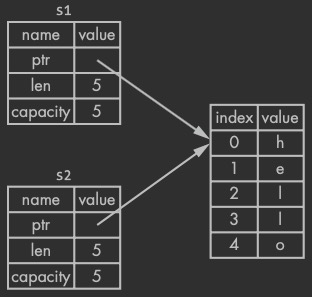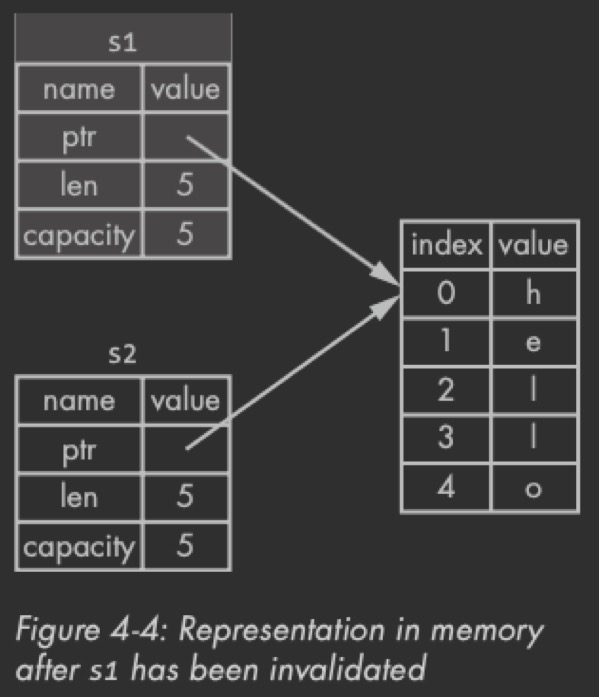Rust 学习笔记(三)Ownership
#ProgrammingLanguage/Rust
ownership:
参考:“Level Up Your Concurrency Skills With Rust” by David Sullins - YouTube
Rust的核心特点就是ownership,保证了rust的内存安全,而不需要垃圾收集机制。还需要理解几个相关的概念:borrowing, slices。以及rust怎么在内存中布置数据。
rust中,内存是通过所有权系统管理的,该系统具有一组规则,编译器会在编译时检查这些规则。不会像垃圾回收机制一样,降低运行速度和效率。
ownership rules:
- Rust中的每个值都有一个变量,称为其owner。
- 同一时间,只会有一个owner。
- 当owner超出范围,该值会被丢弃删除
let s = String::from("hello"); //另一种初始化String变量的办法
variable scope
{ // s is not valid here; it's not yet declared
let s = "hello"; // s is valid from this point forward
// do stuff with s
} // this scope is now over, and s is no longer valid
memory and allocation 当一个String变量超出域(使用范围),rust会调用一个特殊的函数drop,也就是在此刻,String变量占用的内存被回收。(PS: 类比C++的RAII)。
let s1 = String::from("hello");
let s2 = s1;
println!("{}, world!", s1);
一个字符串变量,在内存中由三个部分组成:
- 一个指向字符串内容的指针
- 所指向数据的长度(byte)
- 当前已使用的长度(byte)
⚠️ (len >= capacity)

代码中第二行,执行时并不会进行内容的复制,而是会如下图所示

一旦执行了第二行代码,就不能使用s1,进行操作了,类似shadow.
执行到第三行代码的时候,实际的数据情况入下图所示

以上的操作,被叫做shallow copy(浅拷贝)
如果在实际编写代码的时候,需要对数据进行真是的复制,即deep copy(深拷贝),就需要使用到一个常见的方法,clone.
let s2 = s1.clone();
⚠️以上的操作都是针对,类似String变量这种,长度不能在运行前确认的情况,其他可变数据结构同理。
针对类似int, float,这类已知数据长度的变量,在变编译的是时候,即可进行快速的拷贝和部署,所以情况和可变长度变量不同。
let x = 5; let y = x;
println! ("x = {}, y = {}", x, y);
以上代码,在赋值后,仍可以访问变量x。
Rust具有一个特殊的注释,称为复制特征,我们可以将其放置在存储在堆栈中的像int,float这类固定长度的变量类型上。如果一个类型具有Copy trait(复制特征),则在分配后仍然可以使用较旧的变量。
可以使用Copy的变量如下:
- 所有的整型变量,比如u32
- 布尔型变量
- 所有的浮点变量,比如f64
- 以上变量组成的Tuples(元组)变量。 总结就是,固定长度的变量,单一或者复合使用,仍然是具有复制特征的,但是变长的数据类型比如String,就没有此特性。
ownership and functions
fn main() {
let mut s = String::from("Hello");
s.push_str(", world");
println!("{}" , s);
let s1 = String::from("hello");
let s2 = s1.clone();
println!("s1 = {}, s2 = {}", s1, s2);
let s = String::from("hello");// s comes into scope
takes_ownership(s); // s's value moves into the function and so is no longer valid here
let x = 5; makes_copy(x);//x would move into the function, but i32 is Copy, so it's okay to still use x afterward
}
fn takes_ownership(some_string: String) { // some_string comes into scope
println!("{}", some_string);
} // Here, some_string goes out of scope and `drop` is called. The backing
// memory is freed.
fn makes_copy(some_integer: i32) { // some_integer comes into scope
println!("{}", some_integer);
} // Here, some_integer goes out of scope. Nothing special happens.
fn main() {
let s1 = String::from("hello");
let (s2, len) = calculate_length(s1);
println!("The length of '{}' is {}.", s2, len);
}
fn calculate_length(s: String) -> (String, usize){
let length = s.len();
(s, length)
}
以上代码有个什么问题呢,我们的主函数,如果还需要继续在主函数中使用变量s1,就需要函数calculate_length,返回变量s.
⚠️ 变量的所有权每次都遵循相同的模式:将值分配给另一个变量将其移动。 当包含堆上数据的变量超出范围时,将删除该值,除非该数据已移至另一个变量所有。
references and borrowing 为了解决上面代码,必须返回,变量所有权的问题,我们来介绍reference。
reference和C++的引用和C语言的参数指针类似。
fn main() {
let s1 = String::from("hello");
let len = calculate_length(&s1);
println!("The length of '{}' is {}.", s1, len);
}
fn calculate_length(s: &String) -> usize {
s.len()
}

我们将calculate_length这种有reference作为参数的函数叫做borrowing。 reference 默认是不可变的,即不可修改所指向的内容。 如果需要修改,需要添加mut关键字。
可变引用有一个很大的限制:只能在一个特定范围内对一个特定的数据段进行一个可变引用。
可以理解为,一块特定的内存或变量不能同时指向两个指针,或者同时被两个引用引用。
let mut s = String::from("hello");
let r1 = &mut s;
let r2 = &mut s;
--------------------------------------------------------------
error[E0499]: cannot borrow `s` as mutable more than once at a time --> borrow_twice.rs:5:19
使用大括号创建新的范围,从而允许多个可变引用。
let mut s = String::from("hello");
{
let r1 = &mut s;
} // r1 goes out of scope here, so we can make a new reference with no // problems.
let r2 = &mut s;
如果是不可变引用和可变引用同时使用呢,答案也是不行的。多个不可变引用是可以的。
let mut s = String::from("hello");
let r1 = &s; // no problem
let r2 = &s; // no problem
let r3 = &mut s; // BIG PROBLEM
--------------------------------------------------------------
error[E0502]: cannot borrow `s` as mutable because it is also borrowed as immutable
小结:
- 只有一个可变引用或者多个不可变引用。
- 引用必须一直有效,类似C语言不能使用指向非法地址的指针。(涉及到后面章节中的生命周期概念)
the slice type 没有所有权的数据类型,被称为slice。 slice可以引用集合中连续的元素序列,而不是整个集合
⚠️ 对迭代器的简单理解 For now, know that iter is a method that returns each element in a collection and that enumerate wraps the result of iter and returns each element as part of a tuple instead. The first element of the tuple returned from enumerate is the index, and the second element is a reference to the element. This is a bit more convenient than calculating the index ourselves.
现在,知道迭代器是一种方法,该方法返回集合中的每一个元素,并对返回的每一个元素进行封装,将每一个元素封装成一个元组,元组的第一个元素是索引,第二个元素是对实际返回元素的索引。这样会比自己判断索引方便一些。

fn first_word(s: &String) -> usize {
let bytes = s.as_bytes(); //通过 as_byts 将String 转变为 数组
//tuple(index , point to data)
//for()将返回的tuple拆分
//bytes.iter() 创建数组bytes的iterator迭代器
for(i, &item) in bytes.iter().enumerate(){
//.iter().enumerate()返回元素的引用
if item == b' ' { // b' ' 表示 代表一个空格的byte
return i;
}
}
s.len();
}
string slices 一个string slices是对String的一部分的引用。
let s = String::from("hello world");
let hello = &s[0..5];
let world = &s[6..11];
实际运行时内存的结构如下图

fn first_word(s: &String) -> &str {
let bytes = s.as_bytes(); //通过 as_byts 将String 转变为 数组
//tuple(index , point to data)
//for()将返回的tuple拆分 //bytes.iter() 创建数组bytes的iterator迭代器
for(i, &item) in bytes.iter().enumerate() { //.iter().enumerate()返回元素的引用
if item == b' ' { // b' ' 表示 代表一个空格的byte
return &s[0..i];
}
}
&s[..]
}